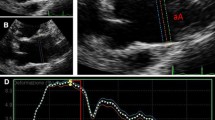Abstract
This study evaluated arterial wall stiffness independent of variant background blood pressure. A new technique—arterial wall stiffness index (AWSI)—was developed and its use verified. Intraluminal pressure and luminal volume were measured on eight swine descending aortas. AWSI was formulated to evaluate absolute arterial wall stiffness independent of variable blood pressure and aortic size. AWSI variability with pressure change was compared with other wall stiffness evaluation parameters. AWSI determined from 100 descending aortic cine CT images and 108 carotid artery ultrasonography datasets were compared with age and Framingham risk score, respectively. Between 50 and 360 mmHg blood pressures, AWSI variance was 5.43% compared to 64.99% for classical compliance. AWSI correlated better with Framingham risk score and age than conservative wall stiffness evaluation methods. AWSI is a suitable method to evaluate arterial wall properties independent of variable background blood pressure and aortic size effects.







Similar content being viewed by others
References
Safar ME, Levy BI, Laurent S et al (1990) Hypertension and the arterial system: clinical and therapeutic aspects. J Hypertens Suppl 8(7):S113–S119
Bader H (1983) Importance of the gerontology of elastic arteries in the development of essential hypertension. Clin Physiol Biochem 1(1):36–56
Wilmer WN, Michael F (1990) Properties of the arterial wall. In: Nichols WW, O’Rourke MF (eds) McDonald’s blood flow in arteries. Edward Arnold, London, pp 77–114
Wada T, Kodaira K, Fujishiro K et al (1994) Correlation of ultrasound-measured common carotid artery stiffness with pathological findings. Arterioscler Thromb 14(3):479–482
Mohiaddin RH, Underwood SR, Bogren HG et al (1989) Regional aortic compliance studied by magnetic resonance imaging: the effects of age, training, and coronary artery disease. Br Heart J 62(2):90–96. doi:10.1136/hrt.62.2.90
Selzer RH, Mack WJ, Lee PL et al (2001) Improved common carotid elasticity and intima-media thickness measurements from computer analysis of sequential ultrasound frames. Atherosclerosis 154(1):185–193. doi:10.1016/S0021-9150(00)00461-5
Takahashi M, Murata K, Mori M et al (1992) Evaluation of arterial distensibility using cine MR imaging. Nippon Igaku Hoshasen Gakkai Zasshi 52(7):921–927
Benetos A, Adamopoulos C, Bureau JM et al (2002) Determinants of accelerated progression of arterial stiffness in normotensive subjects and in treated hypertensive subjects over a 6 year period. Circulation 105(10):1202–1207. doi:10.1161/hc1002.105135
O’Rourke MF, Staessen JA, Viachopoulos C et al (2002) Clinical applications of arterial stiffness; definitions and reference values. Am J Hypertens 15(5):426–444. doi:10.1016/S0895-7061(01)02319-6
Kuecherer HF, Just A, Kirchheim H (2000) Evaluation of aortic compliance in humans. Am J Physiol Heart Circ Physiol 278(5):H1411–H1413
Cockcroft JR, Wilkinson IB (2002) Arterial stiffness and pulse contour analysis: an age old concept revisited. Clin Sci (Lond) 103(4):379–380
Kaibe M, Ohishi M, Komai N et al (2002) Arterial stiffness index: a new evaluation for arterial stiffness in elderly patients with essential hypertension. Geriatr Gerontol Int 2(4):199–205. doi:10.1046/j.1444-1586.2002.00045.x
Nichols WW (1990) Properties of the arterial wall. In: Nichols WW, O’Rourke MF (eds) McDonald’s blood flow in arteries. Edward Arnold, London, p 96
Nollen GJ, Westerhof BE, Groenink M et al (2004) Aortic pressure-area relation in Marfan patients with and without beta blocking agents: a new non-invasive approach. Heart 90(3):314–318. doi:10.1136/hrt.2003.010702
Frank O (1926) Die theorie der pulswellen. Z Biol 85:91–130
Goldwyn RM, Watt TB (1967) Arterial pressure pulse contour analysis via a mathematical model for the clinical quantification of human vascular properties. IEEE Trans Biomed Eng 14:11–17. doi:10.1109/TBME.1967.4502455
Randall OS, Esler MD, Calfee RV et al (1976) Arterial compliance in hypertension. Aust N Z J Med 2:49–59
Amar J, Ruidavets JB, Chamontin B et al (2001) Arterial stiffness and cardiovascular risk factors in a population-based study. J Hypertens 19(3):381–387. doi:10.1097/00004872-200103000-00005
Kelly R, Hayward C, Avolio A et al (1989) Noninvasive determination of age-related changes in the human arterial pulse. Circulation 80(6):1652–1659
Bank AJ, Wilson RF, Kubo SH et al (1995) Direct effects of smooth muscle relaxation and contraction on in vivo human brachial artery elastic properties. Circ Res 77(5):1008–1016
Bussy C, Boutouyrie P, Lacolley P et al (2000) Intrinsic stiffness of the carotid arterial wall material in essential hypertensives. Hypertension 35:1049–1054
Drzewiecki G, Field S, Moubarak I et al (1997) Vessel growth and collapsible pressure-area relationship. Am J Physiol Heart Circ Physiol 273:H2030–H2043
Erbel R, Alfonso F, Boileau C et al (2001) Diagnosis and management of aortic dissection. Eur Heart J 22(18):1642–1681. doi:10.1053/euhj.2001.2782
Hansmann HJ, Dobert N, Kucherer H et al (2000) Various spiral CT protocols and their significance in the diagnosis of aortic dissections: results of a prospective study. Rofo 172(11):879–887
Boese JM, Bock M, Schoenberg SO et al (2000) Estimation of aortic compliance using magnetic resonance pulse wave velocity measurement. Phys Med Biol 45(6):1703–1713. doi:10.1088/0031-9155/45/6/320
Bock M, Schad LR, Muller E et al (1995) Pulsewave velocity measurement using a new real-time MR-method. Magn Reson Imaging 13(1):21–29. doi:10.1016/0730-725X(94)00077-G
Long A, Rouet L, Bissery A et al (2004) Compliance of abdominal aortic aneurysms: evaluation of tissue Doppler imaging. Ultrasound Med Biol 30(9):1099–1108. doi:10.1016/j.ultrasmedbio.2004.08.007
Hoeks AP, Ruissen CJ, Hick P, Reneman RS (1985) Transcutaneous detection of relative changes in artery diameter. Ultrasound Med Biol 11(1):51–59. doi:10.1016/0301-5629(85)90007-9
Acknowledgments
“This research was supported by the MKE (The Ministry of Knowledge Economy), Korea, under the ITRC(Information Technology Research Center) support program supervised by the IITA(Institute for Information Technology Advancement)” (IITA-2008-C1090-0804-0004)
Author information
Authors and Affiliations
Corresponding author
Rights and permissions
About this article
Cite this article
Seo, J., Choi, D., Rienmueller, R. et al. Suggestion for a new image-based aortic wall stiffness evaluation technique: arterial wall stiffness index. Int J Cardiovasc Imaging 25 (Suppl 1), 83–94 (2009). https://doi.org/10.1007/s10554-008-9413-2
Received:
Accepted:
Published:
Issue Date:
DOI: https://doi.org/10.1007/s10554-008-9413-2




